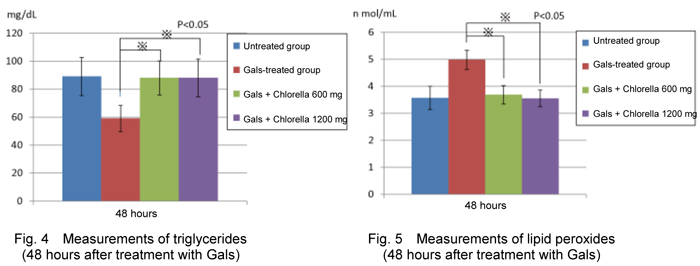- TOP
- List of reports
- Protective effect of Chlorella pyrenoidosa against hepatic disorder in rats
Protective effect of Chlorella pyrenoidosa against hepatic disorder in rats
【Scientific information】
Research and Development Department, Sun Chlorella Corporation
Protective effect of Chlorella pyrenoidosa against hepatic disorder in rats
Published in Japanese Pharmacology & Therapeutics (43[10], 2015)
- Objectives
- Hepatic disorder is a serious health problem in many regions in the world, including Japan and Asia. Chlorella pyrenoidosa (hereafter, "Chlorella") is a high-protein and is a green alga that contains various vitamins, minerals, and essential amino acids in a well-balanced manner. Administration of Chlorella has been demonstrated to normalize liver function, lipid metabolism, and protein metabolism in rats with fatty liver. In addition, administration of Chlorella has been reported to lower serum transaminase (ALT [GOT*1] and AST [GPT*2]) levels in patients infected with chronic hepatitis C virus. We performed a more detailed investigation of the effect of Chlorella to improve hepatic disorder by measuring the levels of ALP*3, triglycerides, and lipid peroxides in addition to GOT and GPT.
- Methods
- Rats with hepatic disorder were prepared by intraperitoneal injection of 1000 mg/kg of
D-galactosamine (hereafter, "Gals")*4. The study consisted of the following 4 experimental groups
of 10 animals each: untreated (intraperitoneal injection of physiological saline alone) group,
Gals-treated (intraperitoneal injection of 1000 mg/kg of Gals) group, Gals plus oral Chlorella 600
mg/kg/day (given as 2 divided doses of 300 mg/kg each in the morning and evening) group, and
Gals plus oral Chlorella 1200 mg/kg/day (given as 2 divided doses of 600 mg/kg each in the
morning and evening) group. Chlorella was administered orally by gavage a total of 8 times
according to the experimental schedule shown in Fig. 1.
GOT, GPT, and ALP activities were measured 8, 24, and 48 hours after administration of Gals.
- Results
- Figures 2 and 3 show the effects of Chlorella on GOT, GPT, and ALP activities in rats with hepatic
disorder caused by Gals loading. The GOT, GPT, and ALP activities after administration of Gals
were higher than those in the untreated group, but the increases in GOT and GPT activities in the
Gals plus Chlorella 600 or 1200 mg/kg/day group were significantly inhibited by Chlorella, as
compared with those in the Gals-treated group.
Figure 4 shows the effects of Chlorella on the activities of serum triglycerides in rats with hepatic disorder caused by Gals loading. The triglyceride activity after administration of Gals was lower than that in the untreated group, but was significantly higher in the Gals plus Chlorella 1200 mg/kg/day group than in the Gals-treated group.
Figure 5 shows the effects of Chlorella on serum lipid peroxides in rats with hepatic disorder caused by Gals loading. Lipid peroxide levels were measured by coloring them red by reaction with thiobarbituric acid. The lipid peroxide levels after administration of Gals were higher than that in the untreated group, but the increase in lipid peroxide level in the 2 Chlorella groups was significantly inhibited by Chlorella, as compared with that in the Gals-treated group.
- Discussion
- Administration of Chlorella significantly inhibited increases in GOT, GPT, and ALP activities, and lipid peroxide levels, all of which are usually increased in rats with hepatic disorder. In addition, administration of Chlorella returned triglyceride levels to normal, which are usually decreased in rats with hepatic disorder. On the basis of these results, Chlorella was suggested to be useful in promoting recovery from hepatic disorder.



Terminology
- *1:GOT (glutamic oxaloacetic transaminase)
- An enzyme in hepatocytes. Because blood GOT levels increase as the destruction of hepatocytes proceeds, the GOT level is used as an indicator of the degree of hepatocyte destruction caused by hepatitis viruses or drugs. GOT is also contained in cardiomyocytes and skeletal muscle cells in addition to hepatocytes, and therefore the GOT level can serve as an indicator of diseases involving the heart and skeletal muscles.
- *2:GPT (glutamic pyruvic transaminase)
- Similarly to GOT, GPT is contained in hepatocytes, cardiomyocytes, and skeletal muscle cells, and therefore the GPT level can serve as an indicator of diseases involving the liver, heart, and skeletal muscles.
- *3: ALP (alkaline phosphatase)
- An enzyme produced by hepatocytes and other various cells in the body. Hepatic disorder is associated with the leakage of ALP into blood, resulting in increased blood ALP levels.
- *4:D-galactosamine (Gals)
- D-galactosamine (Gals) may induce clinical manifestations similar to those of human viral hepatitis. An increased dose of Gals is known to induce fulminant hepatitis-like conditions.
Details
- Journal:
- Japanese Pharmacology & Therapeutics (monthly publication), 43 (10), published on October 20, 2015.
- Title:
- Protective Effect of Chlorella pyrenoidosa against Hepatic Disorder in Rats
- Authors:
- Hiroko Ito1), Yukari Arakawa2), Masaki Fujishima2), Masato Onishi2), Fukuyoshi Nakata3), and Hitoshi Ito4)
- Affiliation:
- 1) Laboratory of Marine Biochemistry, Faculty of Bioresources, Mie University
2) Sun Chlorella Corp., Research and Development Department
3) Power Full Health Foods Corp.
4) Research Institute of Mycology and Pharmacology





